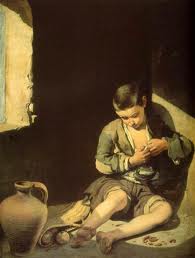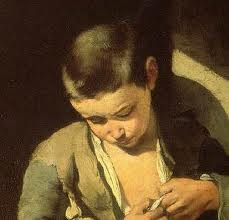El joven mendigo
'El Joven Mendigo' (The Young Beggar) was painted by Bartolomé Esteban Murillo around the year of 1650. The painting formed one of the more Realist focused paintings of his career, yet it still contains some Baroque elements, the style for which he is most famous.
The Painting

The painting, 'El Joven Mendigo', is an oil painting on a canvas background and measures 1.34 metres in height by 1.1 metres in width. The painting is also known by the name 'el Niño espulgándose' (The Grooming Child).
The painting depicts a young boy who is dressed in rags, sat on the floor in a dusty room. The boy is looking down, concentrating on the piece of his shirt with which he is fiddling with his hands. The boy's feet are bare and dirty, suggesting that he has not been wearing shoes for a long time. All these signs point to the fact that the boy is either a beggar or a street rascal.
On the left hand side of the boy is a ceramic pot and a basket, from which some apples are spilling out onto the floor. On his right, we can see the remains or shells of what appears to be a crab or a prawn. The objects could themselves be said to be an example of Bartolomé Esteban Murillo's still-life works as they are so detailed and show his skill in painting different types of material, such as the terracotta of the pot and the weaves in the basket.
The whole scene is lit by the incoming natural light which is painted in the chiaroscuro style. This style was commonplace during the Baroque period and was used often by the Italian painter Caravaggio. The light is entering the scene from the window to the left hand side, above the pot and basket of apples. Further elements of Baroque painting can be found in 'El Joven Mendigo'. The composition of the painting is based around diagonal lines and axes, which was a typical feature of many Baroque paintings.
With regards to the colours used in 'El Joven Mendigo', there is a rich use of yellows, browns and chestnuts which give the painting a warm feel. This is particularly evident in the colours used for the sunlight falling onto the walls which appear to be from a very hot sun in Spain. This contrasts with the dark browns and blacks of the sections of the room which are in shadow.

Bartolomé Esteban Murillo is more famous for his religious works; however this painting is a perfect representation of Murillo's Realist work. The subtlety of the scene is typical of his style yet it still manages to convey the sadness of the picture.
History
Bartolomé Esteban Murillo painted several paintings of this type with similar subjects of children in the street. At the time, there were many of these children in the streets of Seville, and so they made ample subjects for Murillo's paintings. 'El Joven Mendigo' was the first painting of this collection of works. It is believed by art historians that this painting was commissioned by a foreign, and probably Flemish, merchant in the city of Seville. During this period, paintings of this style were very popular with the Flemish. However others think that 'El Joven Mendigo' was painted by Murillo for a Catholic order, the Franciscans. Murillo used to work for this order and he shared their ideas on the need for charity.
Today, the painting is available to view in the Louvre Museum in Paris where it is displayed with the title 'Le Jeune Mendiant' (The Young Beggar). The painting came to be part of the French collection in 1782 when it was acquired for the collection of King Louis XVI.
